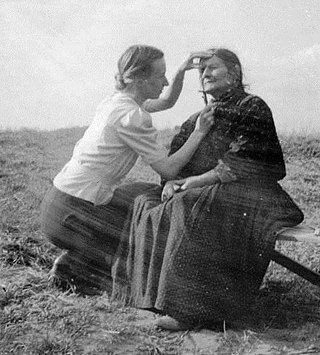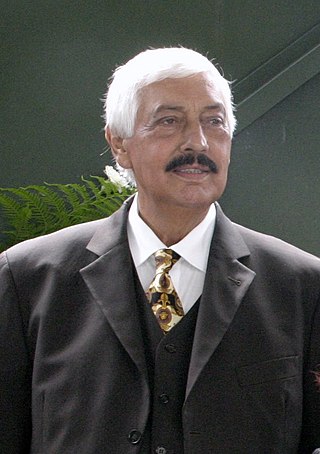Related Research Articles

The Romani Holocaust was the planned effort by Nazi Germany and its World War II allies and collaborators to commit ethnic cleansing and eventually genocide against European Roma and Sinti peoples during the Holocaust era.

The Sinti are a subgroup of Romani people. They are found mostly in Germany, France and Italy and Central Europe, numbering some 200,000 people. They were traditionally itinerant, but today only a small percentage of Sinti remain unsettled. In earlier times, they frequently lived on the outskirts of communities.

The Yenish are an itinerant group in Western Europe who live mostly in Germany, Austria, Switzerland, Luxembourg, Belgium, and parts of France, roughly centered on the Rhineland. A number of theories for the group's origins have been proposed, including that the Yenish descended from members of the marginalized and vagrant poor classes of society of the early modern period, before emerging as a distinct group by the early 19th century. Most of the Yenish became sedentary in the course of the mid-19th to 20th centuries.

Panna Czinka was a famous Hungarian-Romani violinist.
Bohemian Romani or Bohemian Romany was a dialect of Romani formerly spoken by the Romani people of Bohemia, the western part of today's Czech Republic. It became extinct after World War II, due to the genocide of most of its speakers in extermination camps by Nazi Germany.

Ceija Stojka was an Austrian Romani writer, painter, activist, and musician, and survivor of the Holocaust.

Romani Rose is a Romany activist and head of the Central Council of German Sinti and Roma. He lost 13 relatives in the Holocaust.
The Central Council of German Sinti and Roma is a German Romani rights group based in Heidelberg, Germany. It is headed by Romani Rose, who lost 13 members of his close family in the Holocaust. The organization is a member of the Federal Union of European Nationalities.

Eva Justin was a German anthropologist who was active during the Nazi era. She specialised in scientific racism. Her work contributed to the Nazi crimes against the Sinti and Roma peoples.

The Documentation and Cultural Centre of German Sinti and Roma was established in Heidelberg, Germany, in the early 1990s, as a memorial to Sinti and Roma people who were killed by the National Socialists Party. After several years of extension work collecting stories from the victims, conducting research, and conversion, the building complex was ceremonially opened to the public on 16 March 1997, and was supported by the attendance of many Roma and Sinti survivors. It is the world's first permanent exhibition on the genocide perpetrated upon the Sinti and Roma by the Nazis. The documentation Centre has three levels and covers an area of almost 700 square meters, and traces the history and stories of the persecution of the Sinti and Roma under National Socialism. The institution is overseen by Central Council of German Sinti and Roma, supported by the city of Heidelberg, and is the beneficiary of special funds from the German Federal Government and the land of Baden-Württemberg.

Hugo Adolf Höllenreiner was a Sinti survivor of the Porajmos during the Nazi dictatorship.

Jonathan Mack is a German human rights activist, educador and scholar. Mack has a diploma in political sciences of the Free University Berlin, and currently works as political advisor at the Central Council of German Sinti and Roma.
The Deutsches Rechtswörterbuch (DRW) or Dictionary of Historical German Legal Terms is a historic legal dictionary developed under the aegis of the Heidelberg Academy of Sciences and Humanities. The research unit took up work in 1897 and until today has completed 93,155 articles, ranging from Aachenfahrt to selbzwölft. These have been published in 12 consecutive volumes and are also freely accessible online. In course of its research, the DRW also touches upon sources in Old English, of Hanseatic provenance and Pennsylvania German. The research unit will presumably conclude its work in 2036.

Franz "Schnuckenack" Reinhardt was a German gypsy jazz musician (violinist), composer and interpreter. He was considered the "great violin virtuoso of Sinti music." He was a German Sinto; his music was mostly published and categorized under the contemporary names gypsy jazz or "Musik deutscher Zigeuner". He "made this music accessible to a broad public" and made the most significant contribution to the presentation of gypsy music and jazz in Germany into a concert form. He was the pioneer of this style of music in Germany and directly or indirectly inspired many of the succeeding generation of gypsy jazz players in that country, as well as preserving on record a great many folkloric and gypsy compositions for future generations.
Karola Fings is a German historian.
Lily Franz (1924–2011), born Adele Franz, married as Lily van Angeren, published as Lily van Angeren-Franz) was a Sintezza writer. She was arrested with her family in 1943 and taken to Auschwitz concentration camp as part of the Romani Holocaust. Franz survived the camp, testifying against a SS officer. She lived in the Netherlands and published a memoir.
Jane Grier, also known as Miss G.,, was an Irish governess and textile artist. She became known through a colorfully embroidered handkerchief that she made in a psychiatric institution and which is counted as "art brut".
Brigitte Oleschinski is a German political scientist and poet.
Elisabeth Guttenberger was a German Holocaust survivor and human rights activist. Of Sinti origin, she survived the Romani Holocaust and testified at the Frankfurt Auschwitz trials after having been interned at the Gypsy family camp.

Philomena Franz was a Sinti writer and activist from Germany, who was a survivor of the Romani Holocaust, having been imprisoned in Auschwitz. She later published works that recounted her experiences and was recognised as a significant voice in Romani literature.
References
- ↑ "Karlsruherin Anita Awosusi kämpft für die Rechte der Sinti und Roma". Badische Neueste Nachrichten (in German). 2021-07-02. Retrieved 2024-08-04.
- ↑ "Eriac" . Retrieved 2024-08-05.
- 1 2 3 "Anita Awosusi". www.romarchive.eu. Retrieved 2024-08-04.
- ↑ "Anita Awosusi | heimatkunde | Migrationspolitisches Portal der Heinrich-Böll-Stiftung". heimatkunde.boell.de (in German). 2014-12-03. Retrieved 2024-08-04.
- ↑ "Verwobene Geschichte*n - Anita Awosusi". thelivingarchives.org (in German). Retrieved 2024-08-04.
- ↑ "Vorwort | heimatkunde | Migrationspolitisches Portal der Heinrich-Böll-Stiftung". heimatkunde.boell.de (in German). Retrieved 2024-08-04.
- ↑ "Rom Som - Ich bin ein Mensch. Lyrik und Lieder der Sinti und Roma" (PDF). tabkultur.de (in German). Archived from the original (PDF) on 2016-02-21. Retrieved 2024-08-04.
- ↑ "Our Father – A Sinti Family Recounts". Jewish Museum Berlin. Retrieved 2024-08-04.
- ↑ "Auf Wiedersehen im Himmel - Die Sinti-Kinder von der St. Josefspflege - Deutsche Digitale Bibliothek". www.deutsche-digitale-bibliothek.de (in German). Retrieved 2024-08-04.
- ↑ "Archive". CIVIS Medienstiftung: Medienpreis, Mediendialog, Medientalk. Retrieved 2024-08-04.